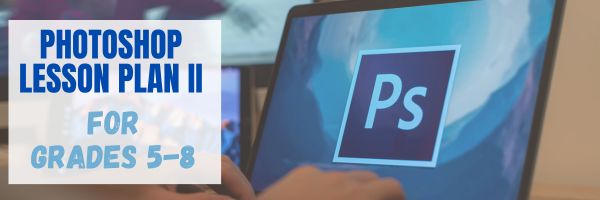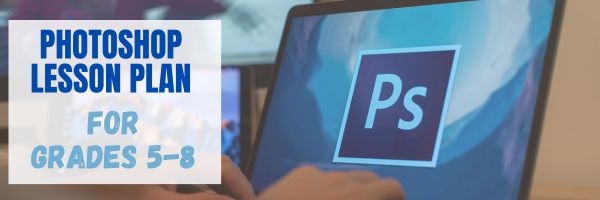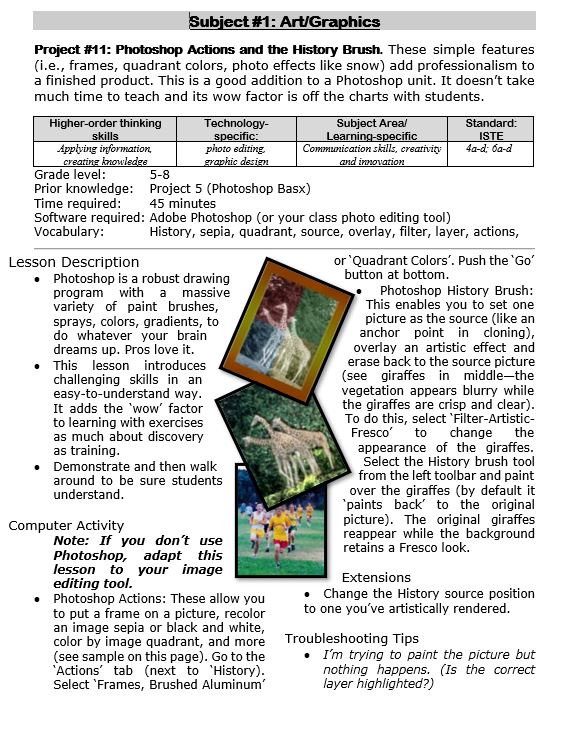Year: 2025
Photoshop Skills Fifth Graders Can Do
The program that says ‘pro’ more than any other is Adobe Photoshop. Believe it or not, there are a whole list of skills easy enough for a fifth grader (maybe even fourth, but I haven’t had time to test it yet).
Over the next months, in this series, I’ll show you how to teach Photoshop skills appropriate for fifth grade and up. The list includes:
- Photoshop artwork–already live
- Photoshop actions–already live
- Photoshop basics
- Photoshop filter and rendering tools
- Photoshop starters–auto-correct with the auto-correction tools–those quick fixes that make a photo look cleaner (coming up)
- Photoshop crop tool–with the lasso and the magic wand
- Photoshop clone tool– within a picture and to another picture
- Photoshop–change the background (put yourself in front of the Eiffel Tower or on top of Hoover Dam)
- Photoshop tools–add custom shapes
- Photoshop–start with Word (a little dated but still useful)
I’ve provided links, but they aren’t live until publication. These can be adapted to other art programs like Canva. Here are examples of the type of project students can create: (more…)
Share this:
- Click to share on Facebook (Opens in new window) Facebook
- Click to share on X (Opens in new window) X
- Click to share on LinkedIn (Opens in new window) LinkedIn
- Click to share on Pinterest (Opens in new window) Pinterest
- Click to share on Telegram (Opens in new window) Telegram
- Click to email a link to a friend (Opens in new window) Email
- More
Happy Memorial Day!
I’m taking Memorial Day (the last Monday in May here in the USA) to honor our soldiers. Hang the American flag and call my two soldier children. Say hi, how are you. When are you coming home to visit? (more…)
Share this:
- Click to share on Facebook (Opens in new window) Facebook
- Click to share on X (Opens in new window) X
- Click to share on LinkedIn (Opens in new window) LinkedIn
- Click to share on Pinterest (Opens in new window) Pinterest
- Click to share on Telegram (Opens in new window) Telegram
- Click to email a link to a friend (Opens in new window) Email
- More
Photoshop Artwork
Photoshop reputation as a photo editor ignores its many other tools that enable you to draw like a pro with a wide variety of brushes, textures, and scintillating extras. This side of Photoshop is perfect for creative projects that tie in with many different classroom lesson plans.
 Want more Photoshop projects available in this project book? Check these out, then click the link below:
Want more Photoshop projects available in this project book? Check these out, then click the link below:
Share this:
- Click to share on Facebook (Opens in new window) Facebook
- Click to share on X (Opens in new window) X
- Click to share on LinkedIn (Opens in new window) LinkedIn
- Click to share on Pinterest (Opens in new window) Pinterest
- Click to share on Telegram (Opens in new window) Telegram
- Click to email a link to a friend (Opens in new window) Email
- More
Photoshop Actions and History Brush
These are simple features ( including frames, quadrant colors, photo effects like snow) that add sophistication and professionalism to a finished product. This is a good addition to a Photoshop unit. It doesn’t take much time to teach and its wow factor is off the charts with students.
Share this:
- Click to share on Facebook (Opens in new window) Facebook
- Click to share on X (Opens in new window) X
- Click to share on LinkedIn (Opens in new window) LinkedIn
- Click to share on Pinterest (Opens in new window) Pinterest
- Click to share on Telegram (Opens in new window) Telegram
- Click to email a link to a friend (Opens in new window) Email
- More
#29: A Slideshow for Third Graders
By fourth grade, my students are so good at PowerPoint, I don’t even teach it in fifth grade (I move on to Photoshop). They’ve learned enough to get them through school. Here’s how I do that: (more…)
Share this:
- Click to share on Facebook (Opens in new window) Facebook
- Click to share on X (Opens in new window) X
- Click to share on LinkedIn (Opens in new window) LinkedIn
- Click to share on Pinterest (Opens in new window) Pinterest
- Click to share on Telegram (Opens in new window) Telegram
- Click to email a link to a friend (Opens in new window) Email
- More
50 Websites About Animals
Here are 50 animal websites for grades K-5, everything from Dinosaurs to the wildly popular Wolfquest (click here for updates):
- 3D Toad—3D science study
- Adaptations—game
- Animal Adaptations
- Animal games
- Animal Games II
- Animal games II
- Animal Games III
- Animal Habitats
- Animal homes
- Animal homes
- Animal Homes II
- Animal Homes III
- Animal puzzle games–cool
- Animals
- Animals—San Diego Zoo Videos
- Barnaby and Bellinda Bear
- Bembo’s Zoo
- Build a habitat
- Build a habitat II
- Butterfies and habitats
- Classify animals
- Cockroach—virtual
- Dino collection
- Dino Fossils then and now
- Dino Games
- Dino Games II
- Dinosaurs
- Dinosaurs II
- Dinosaurs IV
- Dinosaurs V
- Dinosaurs VI
- Endangered species collection
- Food chain
- Food Chains
- Frog habitat
- Google Earth—African Animals
- Google Earth—endangered animals
- Habitat Game
- Habitats—create one
- Habitats—match them
- Life Cycles
- Life—the Game–colorful
- Ocean Currents—video from NASA
- Ocean Safari
- Ocean Tracks
- Video Safari
- Virtual Cockroach
- Virtual Farm
- Virtual Zoo
- Wolfquest—simulation–DL
Share this:
- Click to share on Facebook (Opens in new window) Facebook
- Click to share on X (Opens in new window) X
- Click to share on LinkedIn (Opens in new window) LinkedIn
- Click to share on Pinterest (Opens in new window) Pinterest
- Click to share on Telegram (Opens in new window) Telegram
- Click to email a link to a friend (Opens in new window) Email
- More
Tech Tips to End the School Year
Wrapping up your school technology for the summer is as complicated as setting it up in September. There are endless backups, shares, cleanings, changed settings, and vacation messages that — if not done right — can mean big problems when you return from summer vacation. If you have a school device, a lot of the shutdown steps will be done by the IT folks as they backup, clean, reformat, and maybe re-image your device. If you have a personal device assigned by the school but yours to take home, the steps may be more numerous but really, not more complicated.
Here’s a list. Skip those that don’t apply to you and complete the rest. I won’t take time in this article for a how-to on each activity so if you don’t know how to complete one, check with your IT folks or DDG (Duck Duck Go–or Google) it:
Share this:
- Click to share on Facebook (Opens in new window) Facebook
- Click to share on X (Opens in new window) X
- Click to share on LinkedIn (Opens in new window) LinkedIn
- Click to share on Pinterest (Opens in new window) Pinterest
- Click to share on Telegram (Opens in new window) Telegram
- Click to email a link to a friend (Opens in new window) Email
- More
17 Video Creation Online Tools
- Adobe Spark–suite of free tools for creating images, videos, and simple web pages; quick; great for Chromebooks
- Animoto
- Canva video creator–How-to video by Richard Byrne
- Chromebook–use Chromebook’s native video creation tool; watch this video on how; no add-ons or apps.
- EdPuzzle–edit, quizzify, and add your voice to any video
- Go animate
- Headliner–browser-based video editor; ed version; freemium
- Moovly–free or fee, animated videos
- PlayPosit–interactive videos
- Spark video — works on Chromebooks and iOS; add personal narrative, images. Use a story template or start from scratch; creates as slides
- Unscreen–remove background in videos for free
- Video Editor--free with Windows 10
- Vimeo
- Voki
- WeVideo–collaborative; record on mobile devices; edit on desktop; works great on Chromebooks
- Wideo–create videos online
- Windows 10 organic video editor–how-to video to turn photos into video by Richard Byrne
Share this:
- Click to share on Facebook (Opens in new window) Facebook
- Click to share on X (Opens in new window) X
- Click to share on LinkedIn (Opens in new window) LinkedIn
- Click to share on Pinterest (Opens in new window) Pinterest
- Click to share on Telegram (Opens in new window) Telegram
- Click to email a link to a friend (Opens in new window) Email
- More
Top Grant Sources to Bring Technology to Under-Resourced Classrooms
Top Grant Sources to Bring Technology to Under-Resourced Classrooms
In today’s classrooms, technology is more than a supplement — it’s a necessity. From digital literacy tools to interactive learning platforms, access to reliable technology helps level the educational playing field. However, for many under-resourced schools, affording updated tech remains a major hurdle. Fortunately, a range of grants is available to help educators bring powerful digital tools into their classrooms.
This guide outlines top grant sources dedicated to supporting technology in education, with a special focus on schools in economically disadvantaged areas.
The Realities of Under-Resourced Communities
Before diving into funding sources, it’s important to acknowledge the broader context many schools face. In under-resourced communities, limited school budgets often coincide with other challenges, such as food insecurity, lack of transportation, and especially a shortage of stable, affordable housing.
Housing insecurity, including overcrowding, frequent moves, or even homelessness, can disrupt a student’s ability to attend school consistently, concentrate in class, or complete homework at home. For many students, school may be the only place where they have access to reliable internet, a quiet space to learn, or even a working device. When families are struggling just to keep a roof over their heads, it becomes even more critical that schools can offer strong in-class technology support.
This is where technology grants can make a major impact. By equipping classrooms with up-to-date devices and digital tools, educators can provide a more stable and equitable learning environment — one that compensates, in part, for the challenges students face outside the school walls. (more…)
Share this:
- Click to share on Facebook (Opens in new window) Facebook
- Click to share on X (Opens in new window) X
- Click to share on LinkedIn (Opens in new window) LinkedIn
- Click to share on Pinterest (Opens in new window) Pinterest
- Click to share on Telegram (Opens in new window) Telegram
- Click to email a link to a friend (Opens in new window) Email
- More
Plan Ahead: How to Set Yourself Up for Success Toward a Career in Electrical and Computer Engineering
Plan Ahead: Set Yourself Up for a Career in Electrical and Computer Engineering
Regardless of where you are in your life or at what stage, if you have a dream that you want to achieve, you can start working toward that immediately. If your dreams include working as an electrical and computer engineer, then you can start at any stage of your education process to set yourself up for success.
This starts with taking useful courses whilst still in high school, so that you have to right credentials to get into the university you like, then it’s getting used to online learning, just in case you want to visit an online university and then understanding the future of what you need beyond a BA undergraduate degree like a masters. So, without further ado, it’s time to jump into this topic.
Pick the Right Subjects and Do Your Research
One of the biggest ways to set yourself up for a hopeful career in electrical and computer engineering is by picking the right subjects while you’re still in high school. This often includes IT classes, science, advanced mathematics and economics or technology, whichever your school offers. This will give you the right foundations on which to build toward a degree in this field.
If you have passed the stage of school and you’re simply interested in this degree, there are many things you can do as well. You can spend some time looking at complementary videos on YouTube, for example, that explain the core elements of computers, mathematics and coding, just so that you can put one foot in front of the other as you continue to learn.
Furthermore, you need to set yourself up for success by doing your research and finding the education that suits your needs best. This will be further outlined below.
Have Online Education Systems Replaced Traditional Lectures?
Online education has certainly become a lot bigger and more significant in the market over the past years. This is something that you should keep in mind when looking for where you want to study, as you can find an electrical and computer engineering online degree that gives you access to excellent information, whilst staying at home and being able to engage from all over the world. Digital learning is its own niche and those who have never done it before may not be aware of all the different benefits and challenges, so keep reading to learn more.
Benefits of Online Learning
One of the biggest benefits of online learning is the fact that you can do it from anywhere in the world. This means that you are not forced to stay in one area or classroom for the three or four years that it takes you to get your degree, allowing for a lot more mobility.
Another benefit is the fact that you can access education from all over the world. This means that if you’re in a remote part of a country, you do not need to leave all you know behind in search of excellent education; you can now easily find it online. This creates a saving as well, as you do not need to relocate in pursuit of education, which was once often the case. Also, you don’t have to spend hours commuting to and from an educational establishment, which is a plus.
Furthermore, you’re able to work at the same time, if you can handle it. By visiting an online course, you can slot the hours you need to study when you have the time. You’re not forced to be present between certain hours, giving you more flexibility in your day to do what you need, such as having a job.
Challenges of Online Learning
As with anything good, there are some drawbacks or challenges that you must consider. One of the biggest is self-efficacy and motivation. You have to have your head screwed on right so that you take the responsibility to learn and do as you need to. You have to manage your time well and constantly motivate yourself because no one else will. In online classrooms, you might have some interaction with fellow classmates and lecturers, however, it’s all through a screen and no one is there in person to push you to finish your essays or assignments. This means that the onus falls on you to complete everything.
The Future of Electrical and Computer Engineering
As with most courses, you start with a BA undergraduate degree. You then move on to your master’s, which is where you can pick between many different specialities. This will allow you to find the niche that you think suits you best. Perhaps you are more inclined toward management, in which case, you could learn more about engineering management as opposed to hands-on engineering if you think that you would do well as a leader.
You can always get in touch with the student and subject advisors of the establishment so that they can give you a better idea of the courses you can take and how you can build your curriculum in a way that suits you best.
Well, as you can see from the above, the world of education is changing. With the introduction of technology, things are moving quickly toward online learning and this development comes with certain benefits and challenges. It’s up to you to navigate them with the tools you have at your disposal so that you can earn that degree you’ve worked so hard toward.
Here’s the sign-up link if the image above doesn’t work:
https://forms.aweber.com/form/07/1910174607.htm
“The content presented in this blog are the result of creative imagination and not intended for use, reproduction, or incorporation into any artificial intelligence training or machine learning systems without prior written consent from the author.”
Jacqui Murray has been teaching K-18 technology for 30 years. She is the editor/author of over a hundred tech ed resources including a K-12 technology curriculum, K-8 keyboard curriculum, K-8 Digital Citizenship curriculum. She is an adjunct professor in tech ed, Master Teacher, freelance journalist on tech ed topics, and author of the tech thrillers, To Hunt a Sub and Twenty-four Days. You can find her resources at Structured Learning.
Share this:
- Click to share on Facebook (Opens in new window) Facebook
- Click to share on X (Opens in new window) X
- Click to share on LinkedIn (Opens in new window) LinkedIn
- Click to share on Pinterest (Opens in new window) Pinterest
- Click to share on Telegram (Opens in new window) Telegram
- Click to email a link to a friend (Opens in new window) Email
- More



























































